How to Easily Make Your Own Pyramid Salt Crystals |如何轻松制作你自己的金字塔食盐晶体
Length: • 12 mins
Annotated by howie.serious
howie.serious: source: https://crystalverse.com/pyramid-salt-crystals
Here’s how you can transform regular table salt into gorgeous pyramid salt crystals at home.
这就是你如何在家中将普通的食盐转化为美丽的金字塔盐晶。
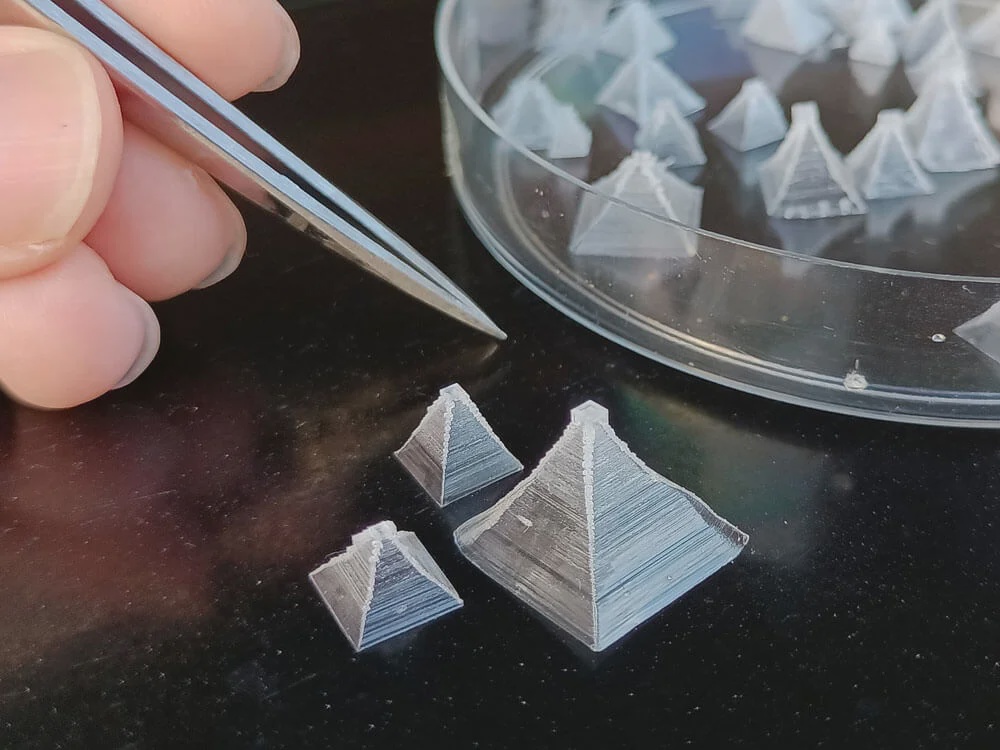
Regular salt looks like a fine white powder. Sure, it tastes good, but it’s not very interesting to look at.
普通的盐看起来就像细白的粉末。当然,它的味道很好,但是看起来并不是很有趣。
But what if I told you that you could transform the salt sitting in your kitchen into a work of art?
但如果我告诉你,你可以将厨房里的盐变成一件艺术品,你会怎么想?
What if I told you that within a few hours, you could turn white, powdery salt into premium salt crystals shaped like pyramids, flowers and Eiffel towers?
如果我告诉你,仅仅几个小时,你就能将白色的粉末状的盐变成形状如金字塔、花朵和埃菲尔铁塔的高级盐晶,你又会怎么想?
Plus, you don’t need to be good at art. You don’t need to carve those pyramids yourself. Just sit beside the stove, and watch as pyramid salt crystals grow from a dish of salt water right before your eyes.
此外,你无需擅长艺术。你不需要亲自雕刻那些金字塔。只需坐在炉边,眼睁睁地看着盐水盘中的金字塔盐晶体生长。
Let me show you how to do just that.
让我来向你展示如何做到这一点。
To my knowledge, it’s the only such guide on the Internet.
据我所知,这是互联网上唯一的此类指南。
First, let’s answer a question.
首先,让我们回答一个问题。
Pyramid salt crystals are made of the same stuff as regular salt. But these crystals look different because they formed in a different way.
金字塔盐晶体与普通盐的成分相同。但由于形成方式的不同,它们的外观却有所区别。
In nature, these elusive crystals grow on the surface of quiet, undisturbed pools of salt water that evaporate under the hot sun.
在大自然中,这些难以捉摸的晶体生长在静谧、未受干扰的盐水池塘表面,这些池塘在炎热的阳光下蒸发。
Pyramid salt is more expensive than regular salt, because they taste saltier. Pyramid salt is hollow, and gram for gram, it dissolves in your mouth faster than regular salt. So the saltiness comes at your taste buds all at once.
金字塔盐比普通盐更贵,因为它们的咸味更浓。金字塔盐是空心的,按克计算,它在你的口中溶解的速度比普通盐快。所以,咸味一下子就冲击到你的味蕾。
Plus, they also look awesome.
而且,它们看起来也非常酷炫。
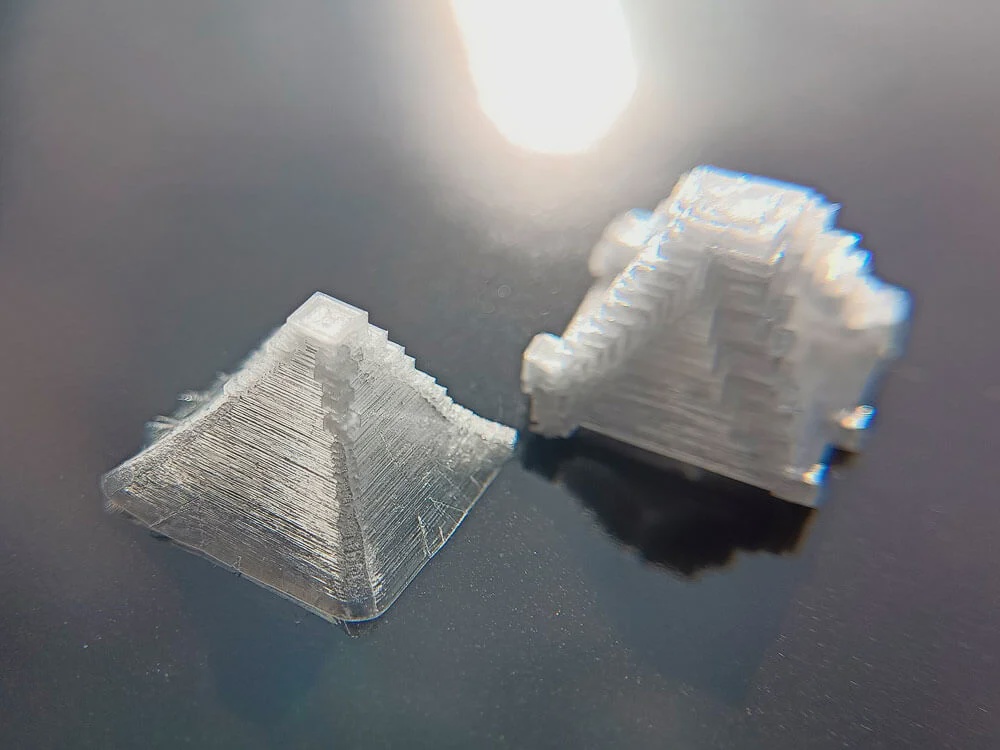
Now, it’s easy to make regular salt crystals at home. Just leave a dish of salt water to evaporate, and you’ll get white powdery salt inside after a few hours.
现在,在家里制作普通的盐晶变得很容易。只需将一盘盐水放置,让其蒸发,几个小时后你就能得到白色的粉末状盐。
However, it’s much harder to make pyramid salt.
然而,制作金字塔形状的盐要困难得多。
True, you can buy them online. Maldon Sea Salt, for instance, contains crunchy pyramidal salt crystals. They are made by evaporating sea water in large heated pans, mimicking nature.
的确,你可以在网上购买。例如,Maldon海盐就包含了脆脆的金字塔形状的盐晶体。它们是通过在大型加热盘中蒸发海水制成的,模仿自然。
But that kind of salt is produced industrially, with special equipment and mineral rich seawater.
但是那种盐是通过工业生产的,需要特殊的设备和富含矿物质的海水。
I’ve always wondered whether you could grow pyramids at home using a hot plate, a glass dish and some regular table salt.
我一直在想,是否可以在家里用电热板、玻璃盘和一些普通的食盐来培养金字塔。
It took over 100 experiments and some sleepless nights, but here are the results.
经过一百多次的实验和一些不眠之夜,这就是我们的结果。
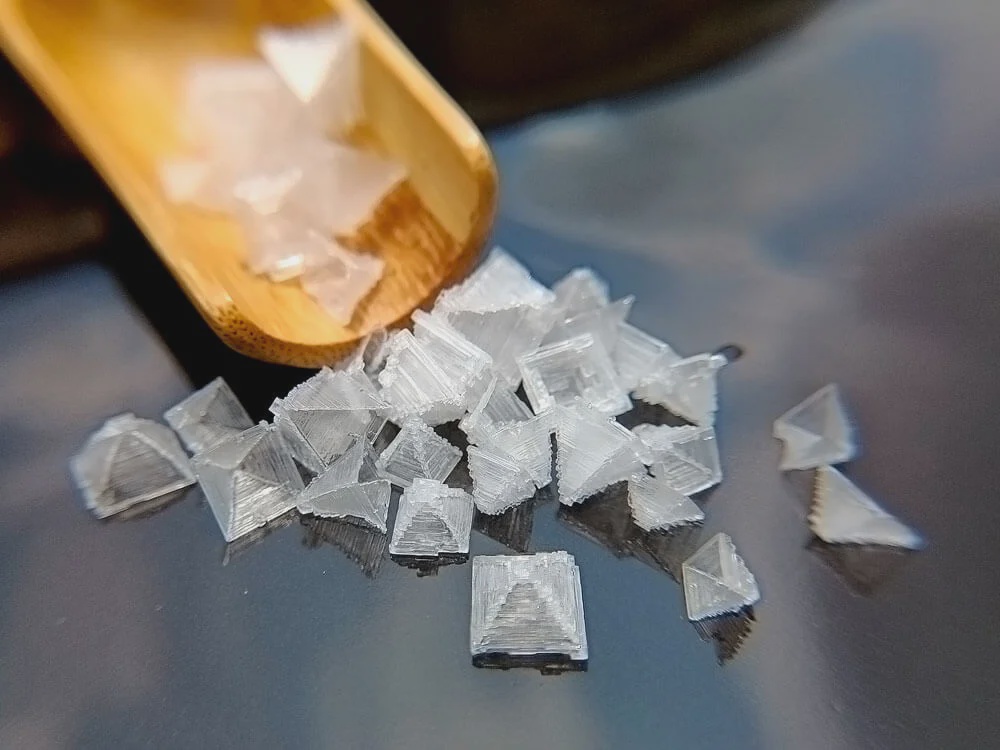
This guide will consist of the following parts:
本指南将包括以下部分:
I have tried table salt, sea salt, and Himalayan rock salt, and they all work. Sea salt seems to give better results.
我尝试过食用盐、海盐和喜马拉雅岩盐,它们都有效。海盐似乎能带来更好的效果。
I’ve used both tap and deionized water. Both are fine.
我已经使用过自来水和去离子水。两者都可以。
Also, in this experiment, we’ll be heating some very concentrated salt water. This solution will damage metallic objects, so you can’t use a stainless steel pot.
另外,在这个实验中,我们将加热一些非常浓的盐水。这种溶液会损坏金属物品,所以你不能使用不锈钢锅。
Instead, I suggest using a heat resistant glass dish. The exact type doesn’t matter. You can use a Pyrex dish or an enameled cast iron pot, which won’t get corroded.
相反,我建议使用耐热玻璃盘。具体的类型并不重要。你可以使用Pyrex品牌的玻璃盘或者是搪瓷铸铁锅,这些都不会被腐蚀。
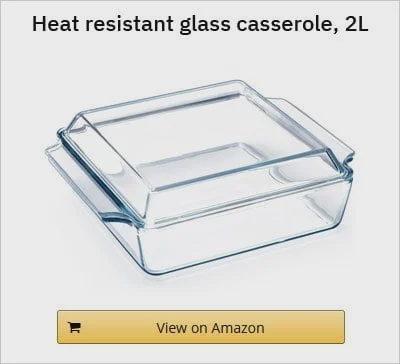
Dissolve 165 g of salt in 500 mL of hot water. If you want to make a bigger batch, just use the same ratio (e.g. 330 g of salt per 1 L of water).
在500毫升的热水中溶解165克的盐。如果你想制作更多的量,只需使用相同的比例(例如,每1升水使用330克的盐)。
Depending on whether the salt is dirty, you can choose to filter it. I filtered mine.
根据盐是否脏污,你可以选择过滤它。我过滤了我的。
In my setup, I poured my filtered salt solution into a glass casserole sitting on top of a hot plate.
在我的设置中,我将过滤后的盐溶液倒入了放在热板上的玻璃砂锅中。
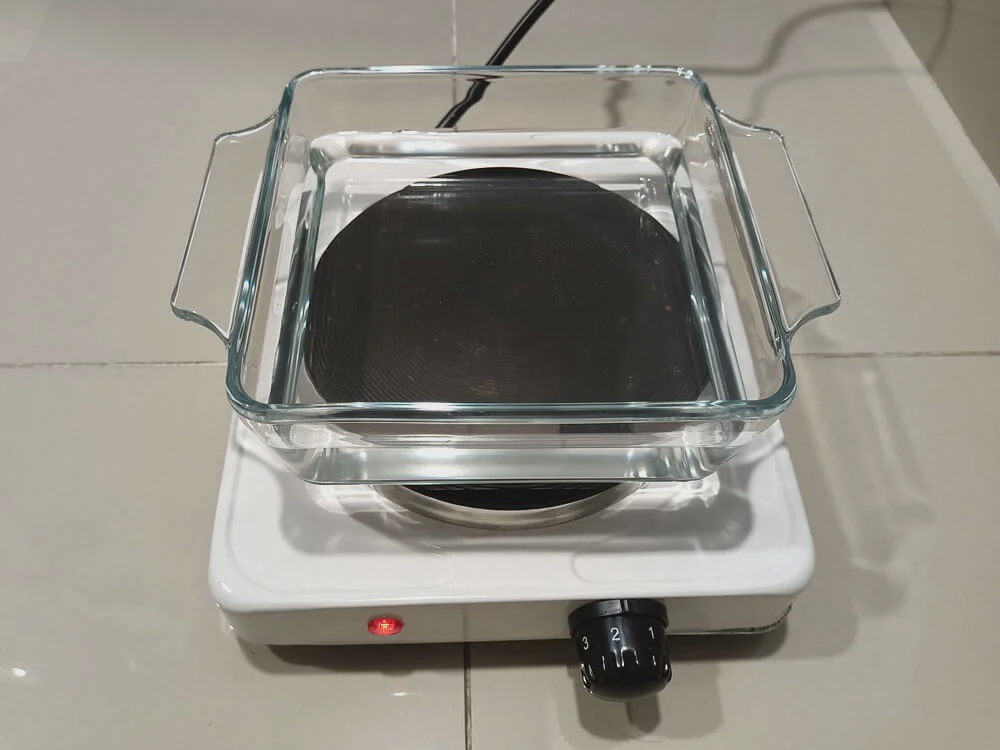
A hot plate is fine. But don’t put the glass dish directly on the gas stove – the glass might break due to strong, uneven heating, even though it is technically heat resistant. Use a water bath instead.
热板是可以的。但是不要直接把玻璃盘子放在煤气灶上 - 尽管玻璃在技术上是耐热的,但由于强烈的、不均匀的加热,玻璃可能会破裂。你应该使用水浴法。
Now, heat the solution to 60-70°C and keep it there throughout the growing process.
现在,将溶液加热至60-70°C,并在整个生长过程中保持此温度。
When the solution warms up, convection currents start forming, causing the surface of the solution to swirl around.
当溶液开始变热时,对流电流开始形成,导致溶液表面产生旋转。
This is bad news, because when our pyramids form, they will also move around the surface of the solution. And they will bump into each other, stick together and fall to the bottom of the dish.
这是个坏消息,因为当我们的金字塔形状开始形成时,它们也会在溶液表面移动。它们会相互碰撞,粘在一起,然后沉到容器的底部。
The key is to add an ingredient called potassium alum. Alum calms the surface and helps the pyramids form. It is normally used in baking and pickling. You can find it at the grocery store, or buy it online.
关键在于添加一种名为明矾的成分。明矾能够使表面平静,帮助形成金字塔。它通常用于烘焙和腌制。你可以在杂货店找到它,或者在网上购买。
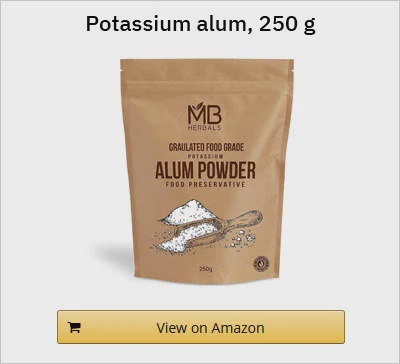
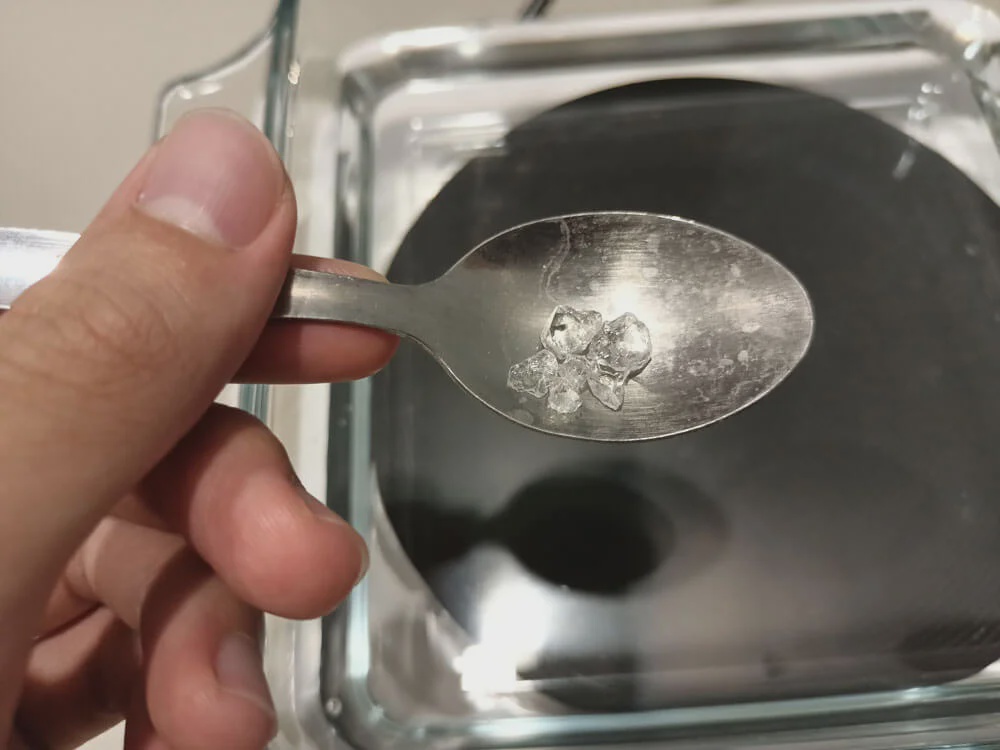
Add 0.5 g of alum per 500 mL of salt solution. No need to measure – just drop a few pea-sized pieces of alum/two pinches of alum powder into the solution and let it dissolve.
每500毫升的盐溶液中添加0.5克的明矾。无需测量 - 只需将几颗豌豆大小的明矾/两撮明矾粉末放入溶液中,让它溶解即可。
Several minutes after the alum has dissolved, the surface of the solution should start to settle down. Check out this GIF:
在明矾溶解几分钟后,溶液的表面应该开始平静下来。看看这个GIF:
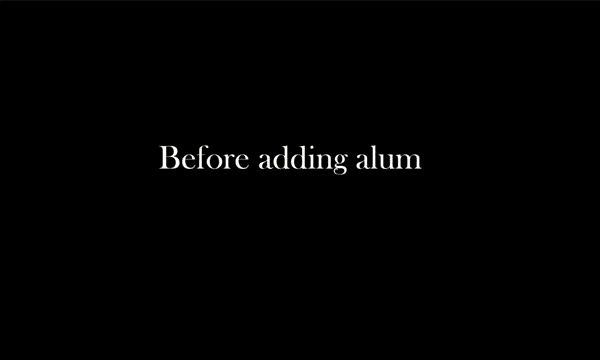
我在溶液表面放了一个软木塞,以便直观地观察表面的运动情况。在加入明矾之前,软木塞会四处旋转。加入明矾后,软木塞完全静止不动。
Good. Now you just need to wait.
很好。现在你只需要等待。
It takes about 30 minutes for the salt solution to reach saturation, which is the point where salt crystals start to form.
盐溶液达到饱和状态大约需要30分钟,这是盐晶体开始形成的时候。
Eventually, small white squares will appear on the surface of the solution.
最终,溶液表面会出现小白色的方块。
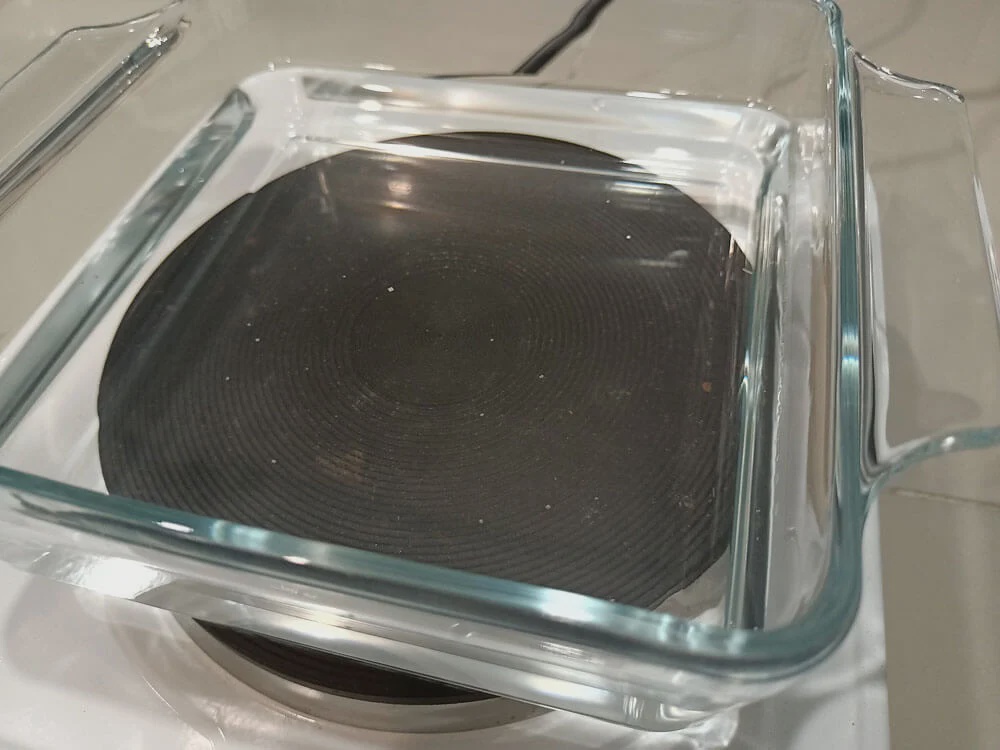
Those are baby pyramid salt crystals.
那些就是崭新的金字塔形盐晶体。
They’ll keep growing, and within 15 minutes they’ll look like this:
他们会继续生长,大约15分钟后,他们会变成这个样子:
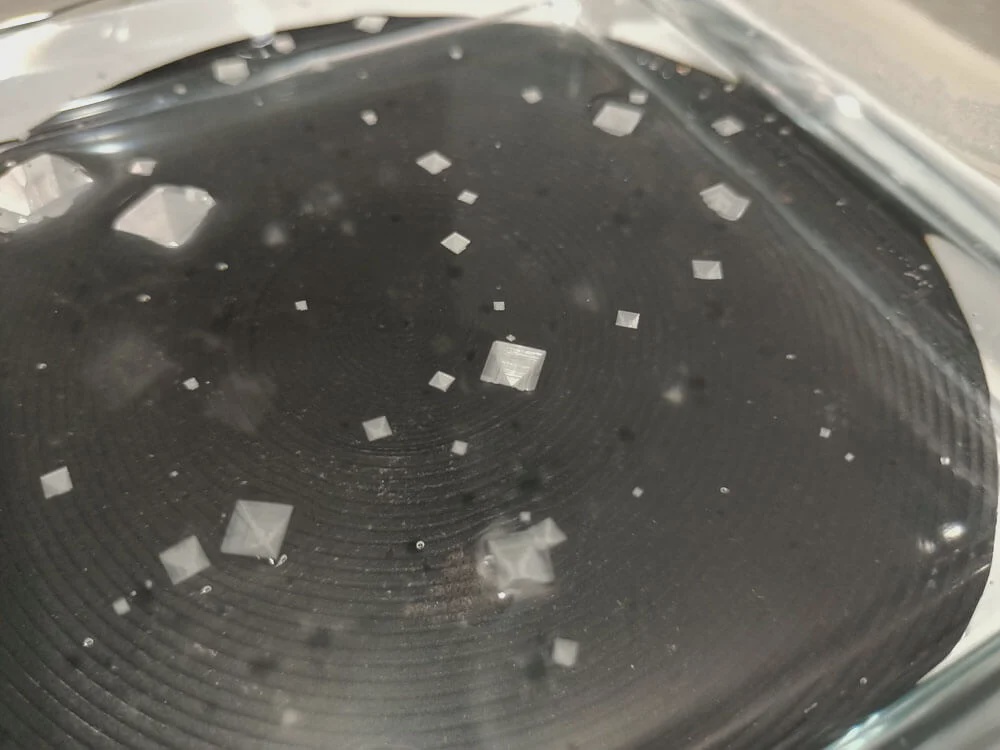
The crystals are actually upside down pyramids, suspended on the surface of the solution due to surface tension. It’s the same principle that lets some insects walk on water.
这些晶体实际上是倒置的金字塔,由于表面张力而悬浮在溶液表面。这与一些昆虫能在水面行走的原理是一样的。
Here’s what they look like from the side:
这就是它们从侧面看起来的样子:
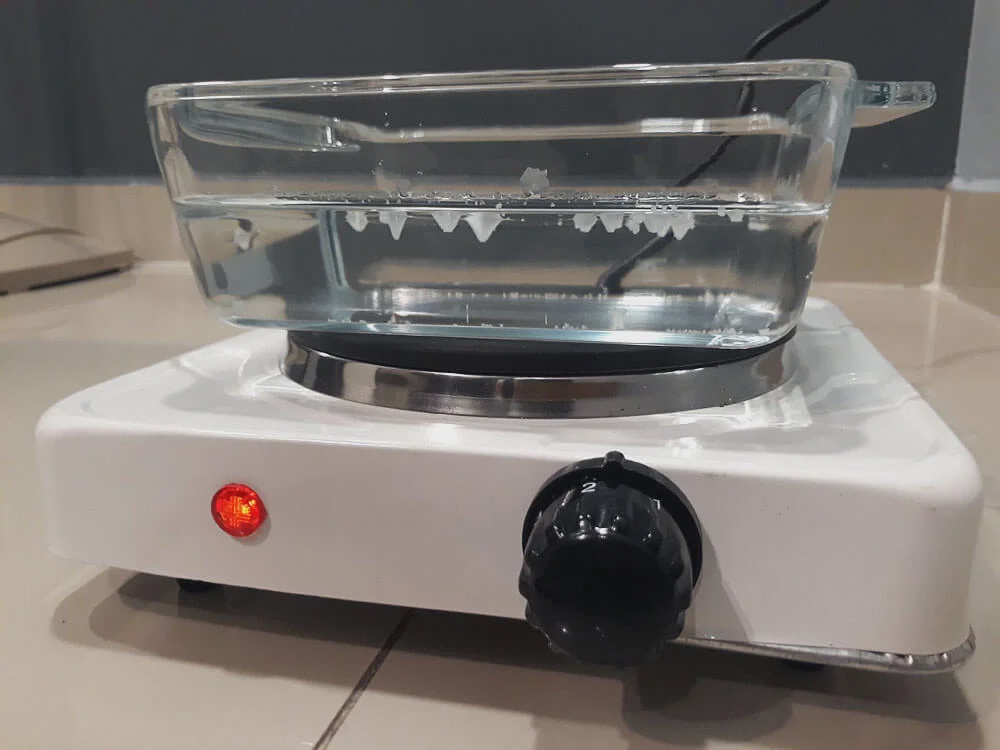
As the pyramid salt crystals get heavier, they sink lower into the solution. But evaporation on the surface causes the base of the pyramids to grow outwards, widening it and forming a staircase pattern in the process.
随着金字塔形状的盐晶体变得越来越重,它们在溶液中沉得越来越低。但是,表面的蒸发使得金字塔的底部向外生长,使其变宽,并在此过程中形成了阶梯状的图案。
Here’s a time lapse of the growing process over 1 hour:
这是一个小时内生长过程的时间延迟摄影:
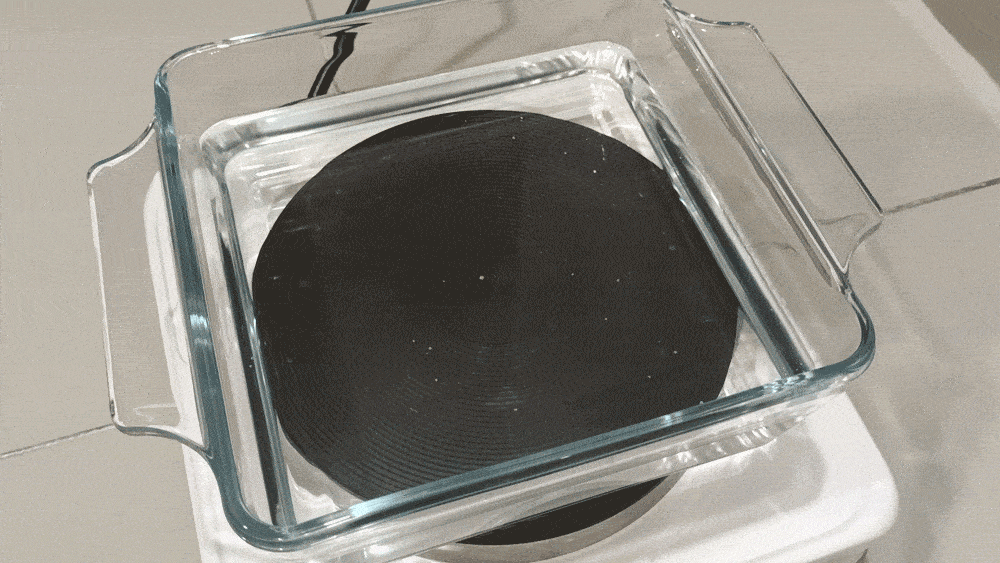
As the pyramids get larger, they risk bumping into their neighbors.
随着金字塔的体积变大,它们有可能会与周围的邻居相撞。
Usually, it isn’t a big problem – unless your solution is too hot. If you heat it beyond 80°C, the pyramids quickly join together to form a layer of crust.
通常,这并不是一个大问题 - 除非你的解决方案过热。如果你将其加热超过80°C,这些金字塔会迅速结合在一起,形成一层硬壳。
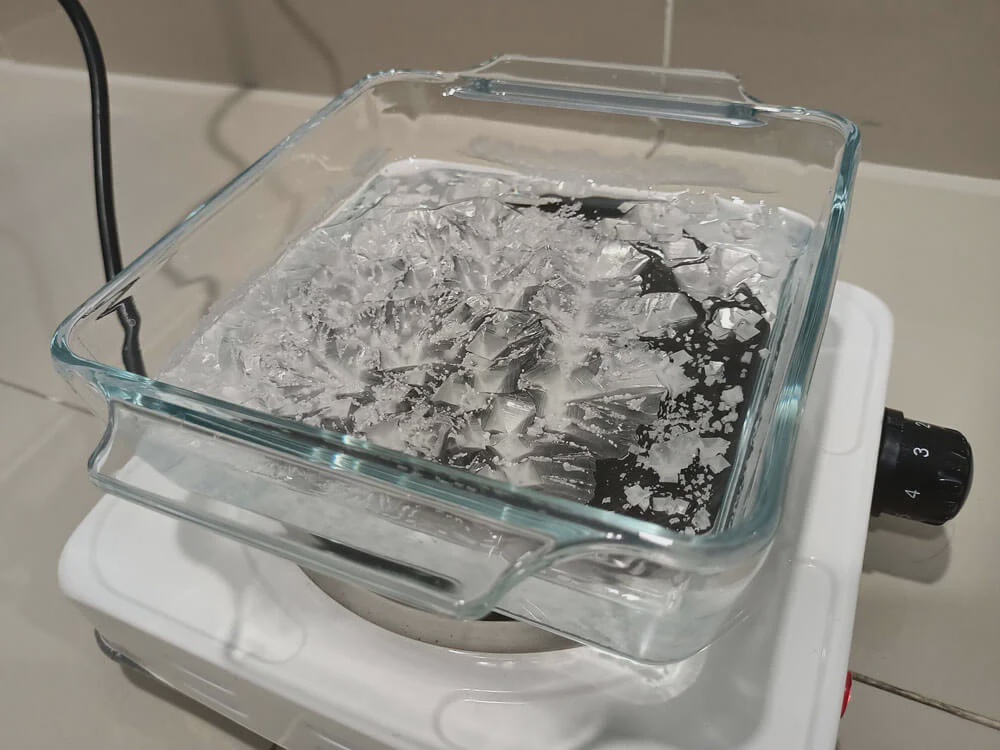
But even at 60°C, you shouldn’t leave them there, because they might get too heavy and fall to the bottom to the dish.
但即使在60°C的温度下,你也不应该把它们留在那里,因为它们可能会变得过于沉重,然后掉到盘子的底部。
So it’s time to harvest the pyramids.
所以,现在是收获金字塔的时候了。
Harvesting the pyramid salt crystals
收获金字塔盐晶体
Using a pair of tweezers, carefully remove the pyramid that you want, and place it on a piece of tissue paper. The paper will soak up excess salt solution.
请使用一把镊子,小心翼翼地取出你想要的金字塔,然后将其放在一张纸巾上。纸巾会吸收多余的盐溶液。
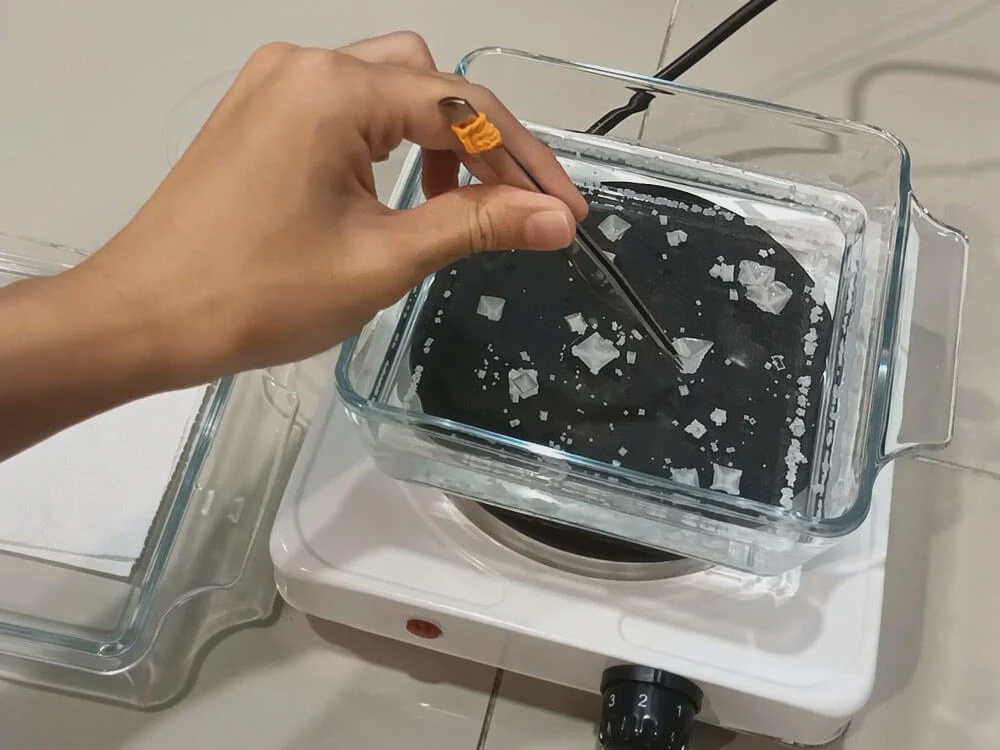
Before you remove the second pyramid, dip the tweezers in a cup of water. This step ensures that there are no powdery salt grains sticking to your tweezers – which will cause thousands of tiny crystals to form in the dish.
在你取出第二个金字塔之前,先将镊子浸入一杯水中。这个步骤确保没有粉末状的盐粒粘在你的镊子上 - 这将在盘子里形成数以千计的微小晶体。
Instead of using tweezers, you can also use a sieve to scoop up those pyramids. Remember to dip the sieve in water after every run.
你也可以使用筛子来取代镊子,用来捞起那些金字塔形状的物体。每次使用后,记得将筛子浸入水中清洗。
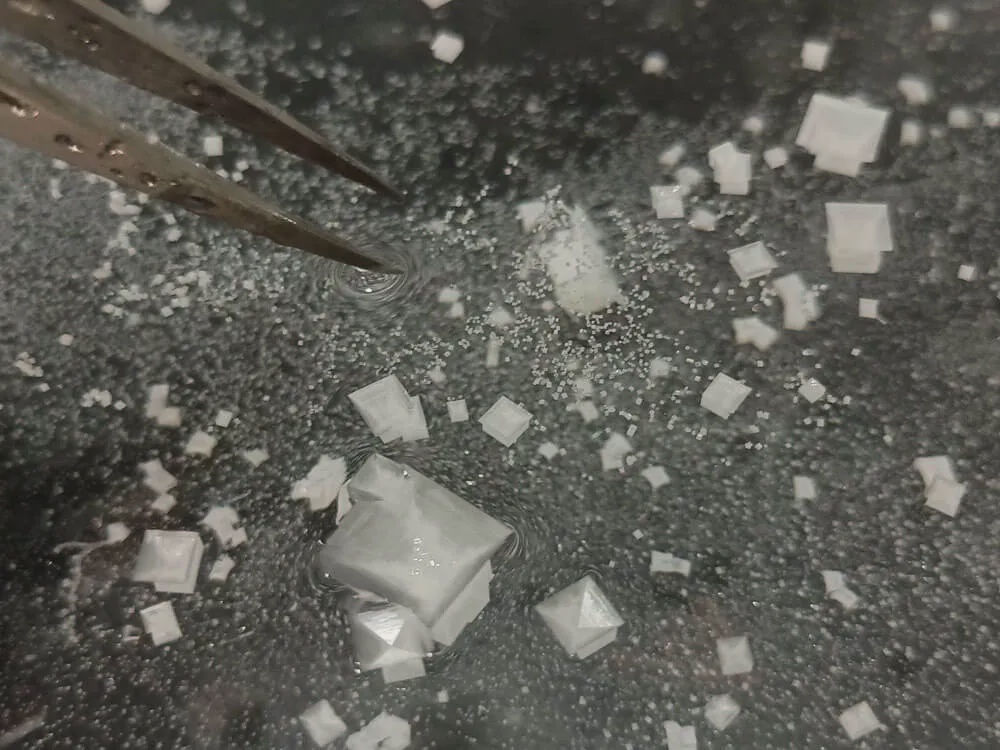
每次使用镊子后,都要清洗干净,以防止粉末状的盐粒形成。
You can keep doing this until the salt water starts to dry out. By this time, you should have quite a few pyramids.
你可以继续这样做,直到盐水开始干涸。到那时,你应该已经有相当多的金字塔了。
You’ve just made the fabled pyramid salt, also known as fleur de sel, flower of salt, at home.
您刚刚在家制作了传说中的金字塔盐,也被称为花之盐,或者盐之花。
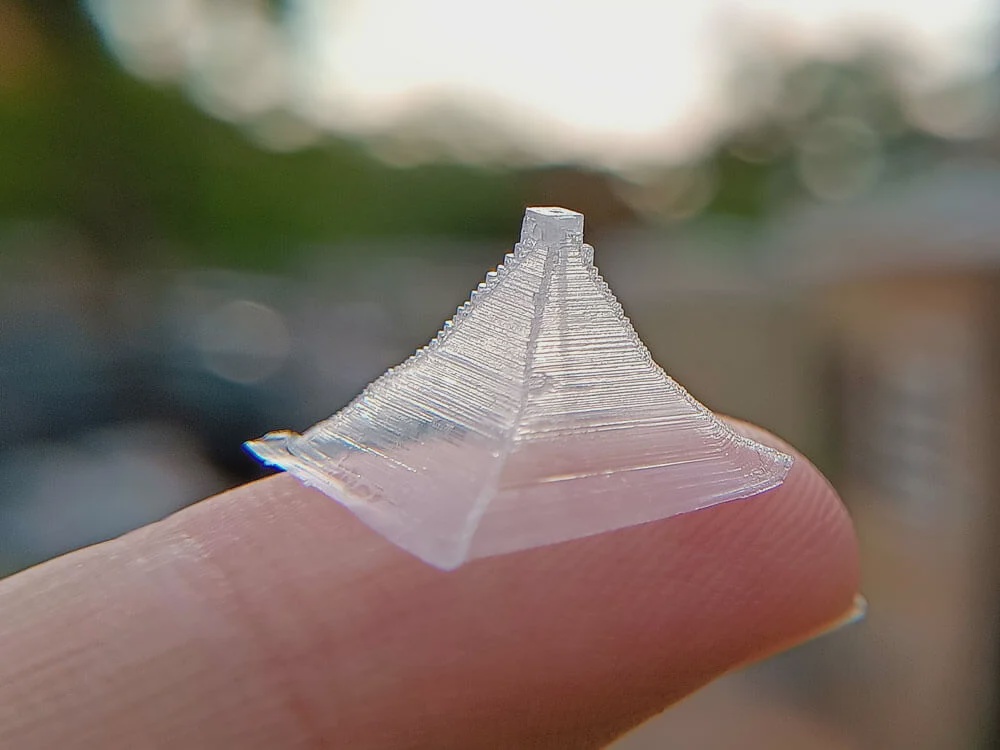
If you want to make more pyramids, just add some water to the dish and wait for all the salt to re-dissolve. Then repeat the process. This time, you don’t need to add alum.
如果您想制作更多的金字塔,只需在盘子里加一些水,等待所有的盐重新溶解。然后重复这个过程。这次,您不需要添加明矾。
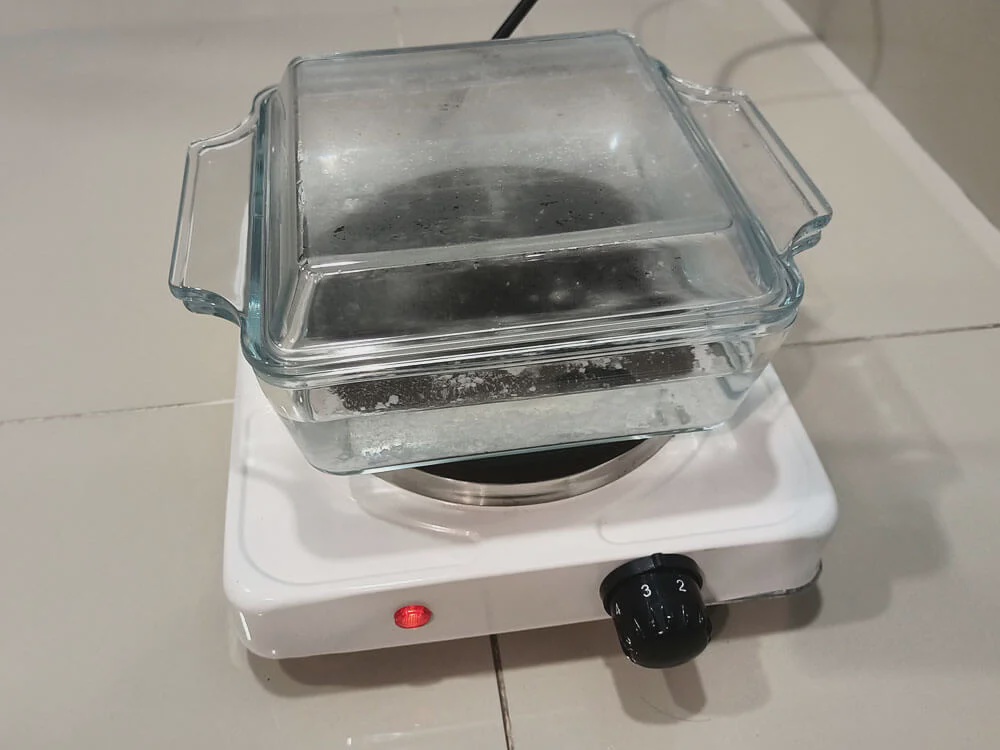
重新溶解盐分以制作更多的金字塔。
Just store them like regular salt.
就像普通盐一样储存它们。
If you live somewhere humid, the crystals will absorb moisture from the air and get slightly wet. This will cause part of the pyramid’s base to dissolve.
如果你生活在湿度较大的地方,这些晶体会吸收空气中的湿气并变得稍微湿润。这将导致金字塔底部的一部分溶解。
It’s no big deal, but if you want to prevent this, store the pyramid salt crystals with a desiccant.
这没什么大不了的,但如果你想防止这种情况,可以将金字塔形状的盐晶体和干燥剂一起存放。
They taste a bit saltier than regular salt. And crunchier.
它们的味道比普通的盐稍微咸一些。而且更脆。
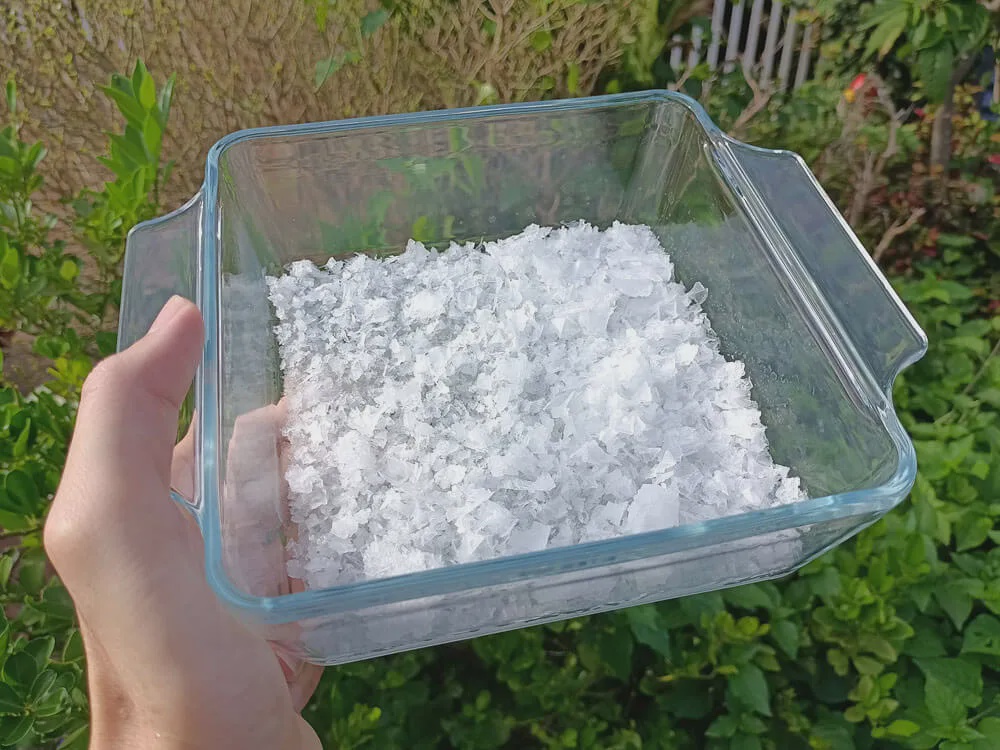
You might also wonder if the alum added to the solution changes the taste of the salt, or if it’s unhealthy.
你可能也会好奇,溶液中添加的明矾是否会改变盐的味道,或者它是否不健康。
First, we added an extremely small amount of alum to the salt solution. So the pyramids taste like pure salt.
首先,我们在盐溶液中添加了极少量的明矾。所以,这些金字塔尝起来就像纯盐。
And since potassium alum is used in baking powder and considered safe by the FDA, it’s alright to bite a pyramid or two.
既然FDA认为在泡打粉中使用的明矾是安全的,那么咬一两个金字塔也没问题。
However, I would discourage you from eating pyramid salt grown with this method regularly. I’m no dietician, and it’s best to look for an expert before adding something new to your diet.
然而,我不建议你经常食用用这种方法生长的金字塔盐。我并非营养师,最好在饮食中添加新的东西前寻求专家的建议。
At the start, I promised you’d see all sorts of pyramid salt crystals, some narrow, others wide. I told tales of Mayan pyramids, flowers and Eiffel Towers.
在开始时,我承诺你会看到各种各样的金字塔形状的盐晶体,有些窄,有些宽。我讲述了玛雅金字塔、花朵和埃菲尔铁塔的故事。
Below you will find pictures of 8 different types of pyramid salt crystals and how I grew them.
下面你将找到8种不同类型的金字塔形状的盐晶体的图片,以及我是如何培养它们的。
Regular pyramids are the most common type of salt crystal. They form from a solution heated to 60-70°C at low to medium humidity.
规则金字塔形是最常见的盐晶体类型。它们是在60-70°C的温度和低至中等的湿度条件下从溶液中形成的。
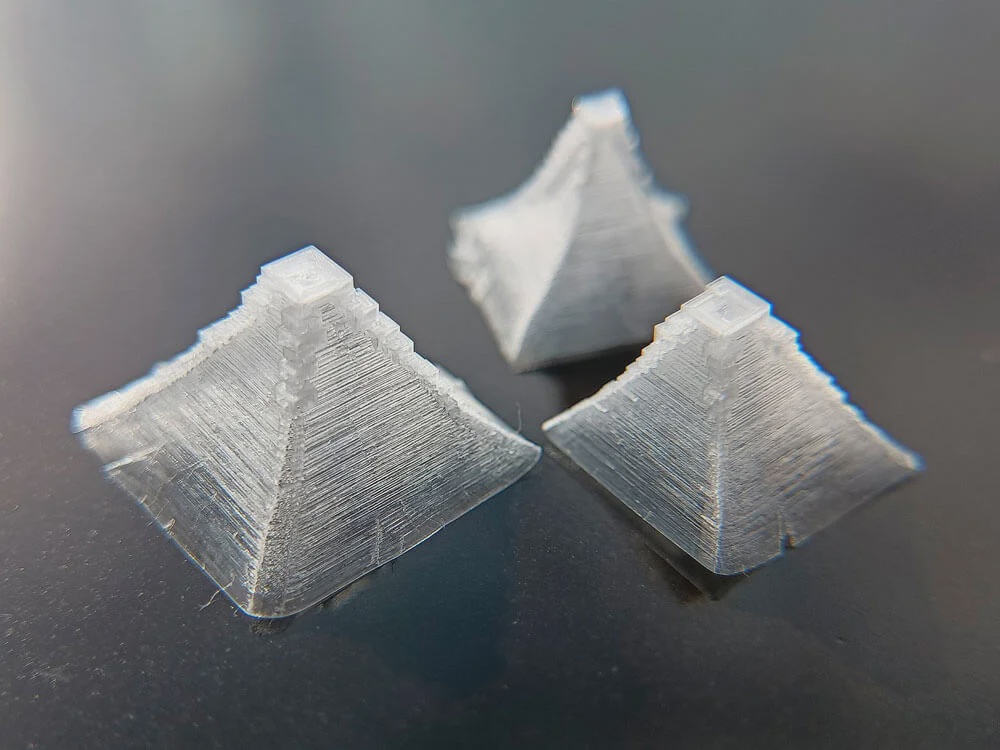
They look like the typical right pyramid, with a square base, and straight edges that meet at the top. The edges have small crystals on them.
它们看起来就像典型的正方形底面的直棱锥,所有的边都在顶部相交。这些边上还镶嵌着小晶体。
Remember, pyramids form upside down – hence, they grow from the top to the bottom. Since salt crystals get larger the longer they stay in the solution, the crystals near the top are bigger than the ones at the bottom.
记住,金字塔是倒着形成的——因此,它们是从顶部向底部生长的。由于盐晶体在溶液中停留的时间越长,其大小就越大,所以靠近顶部的晶体比底部的晶体要大。
Now, regular pyramids are thin and fragile. But if they drop into the solution and are left there, more crystals will deposit on their surface, thickening the faces of the pyramid.
通常,金字塔形状的物体都是薄弱且易碎的。但是,如果它们掉入溶液中并被留在那里,更多的晶体会在其表面沉积,从而增厚金字塔的面。
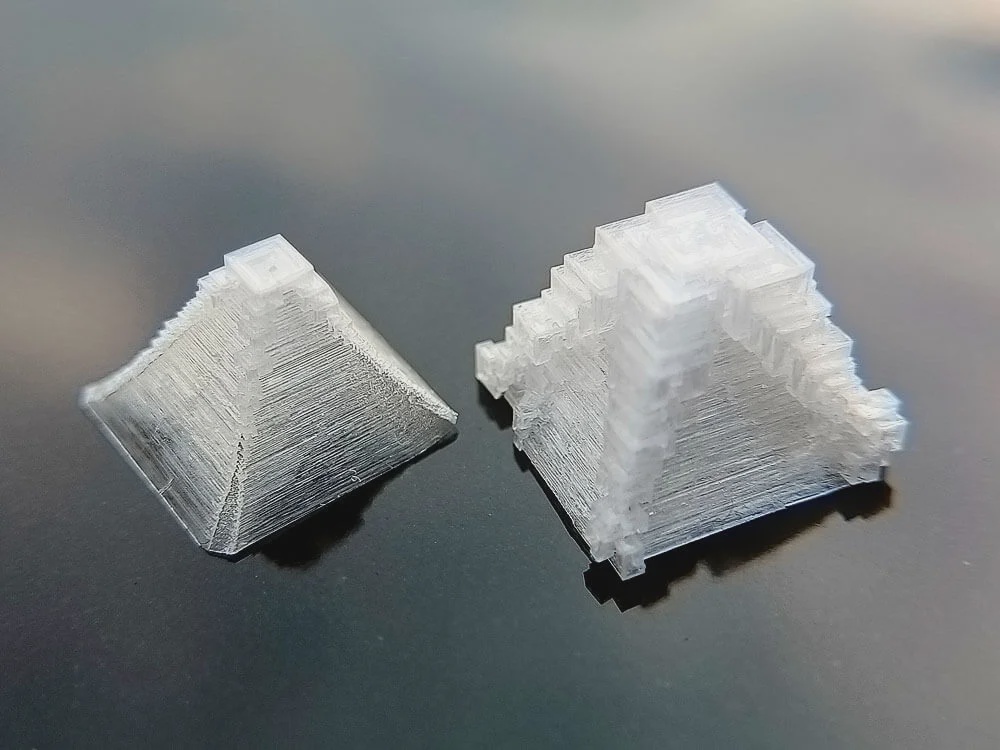
请比较在溶液表面生长的规则金字塔,与那个掉到容器底部并在其表面形成更多晶体以增厚的金字塔。
These “thick” pyramids might look less elegant, but they are also less fragile.
这些“厚重”的金字塔可能看起来不够优雅,但它们也不那么脆弱。
Once, I tried to pick up a pyramid with my tweezers, but by accident, it fell back into the solution. Instead of sinking, it continued to float – but with the tip of the pyramid facing up, and the base facing down.
曾经,我试图用镊子拾起一个金字塔,但不小心,它又掉回了溶液中。它并没有沉下去,反而继续漂浮着——只不过是金字塔的尖端朝上,底部朝下。
I let it grow for another 15 minutes, and the pyramid turned into this magnificent hourglass shaped crystal:
我让它再生长15分钟,金字塔变成了这个壮丽的沙漏形状的晶体:
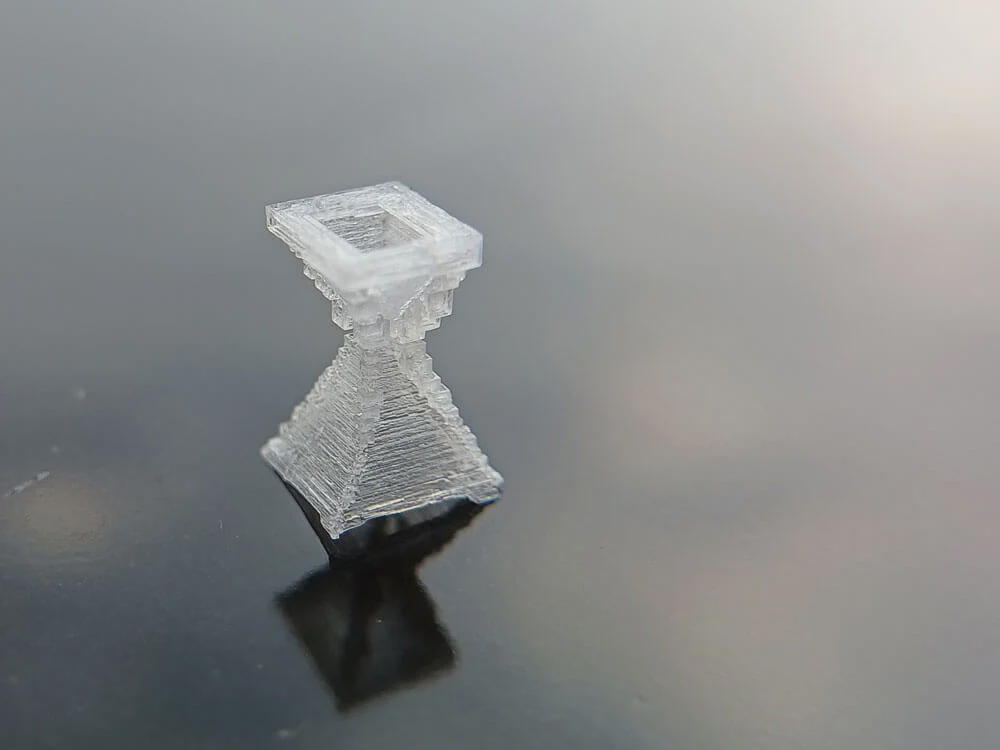
Pyramid growth is a balancing act between gravity and how fast the base of the pyramid can widen. Sometimes, the base of the pyramid grows very slowly, while gravity keeps pulling it downwards.
金字塔的增长是一个平衡行为,它在重力和金字塔底部扩大的速度之间进行调整。有时,金字塔的底部增长非常缓慢,而重力则持续地将其拉向下方。
As a result, we get narrow salt crystals that look less like pyramids and more like Eiffel towers, or chess pieces, if you will.
因此,我们得到的是狭窄的盐晶体,它们看起来更像埃菲尔铁塔或者说是棋子,而不是金字塔。
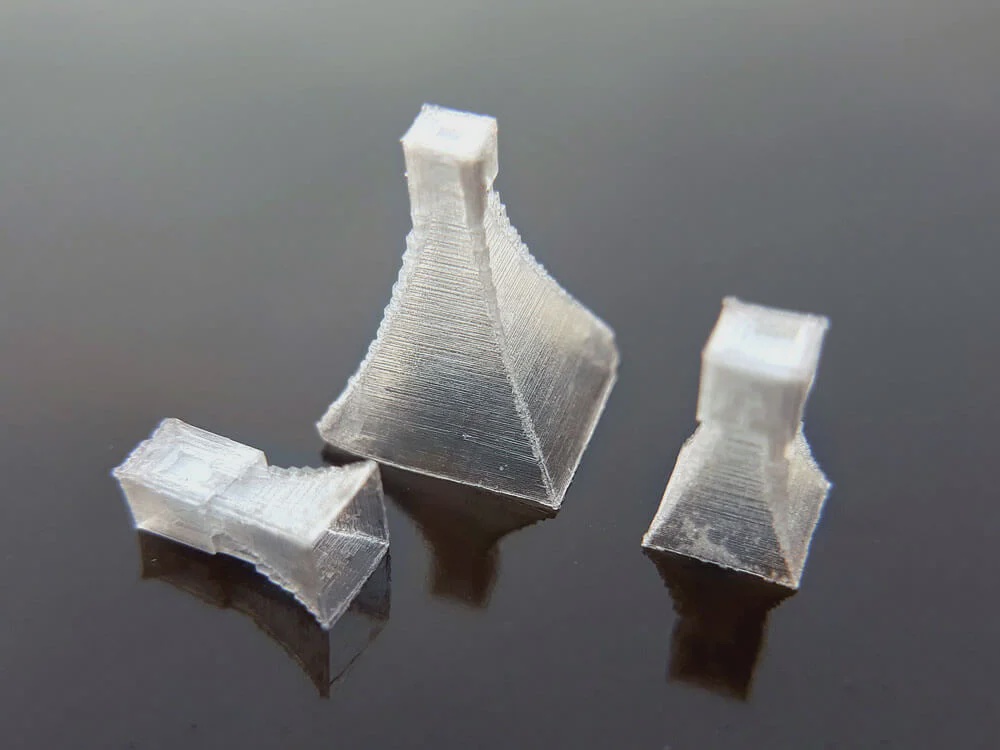
These narrow pyramids like to form when the temperature of the solution is below 60°C.
这些狭窄的金字塔喜欢在溶液温度低于60°C时形成。
My theory is that when the temperature is low, less evaporation occurs, and so less crystal growth occurs at the surface. Thus, the pyramids sink faster than they widen – hence the narrower shape.
我的理论是,当温度较低时,蒸发量会减少,因此表面的晶体生长也会减少。因此,金字塔下沉的速度比它们变宽的速度快 - 这就是形状较窄的原因。
If you increase the temperature while these salt crystals are forming, the base will get wider, curving outwards. The resulting pyramids look like trumpets.
如果在这些盐晶形成时提高温度,底部会变得更宽,向外弯曲。最后形成的金字塔看起来像喇叭。
If you look closely at the pyramids, you’ll find that each pyramid has a “head” at its tip. Sometimes the head is small, sometimes it is big.
如果你仔细观察金字塔,你会发现每个金字塔的顶端都有一个“头”。有时候这个头很小,有时候它很大。
Below are some big headed pyramids.
下面是一些大头金字塔。
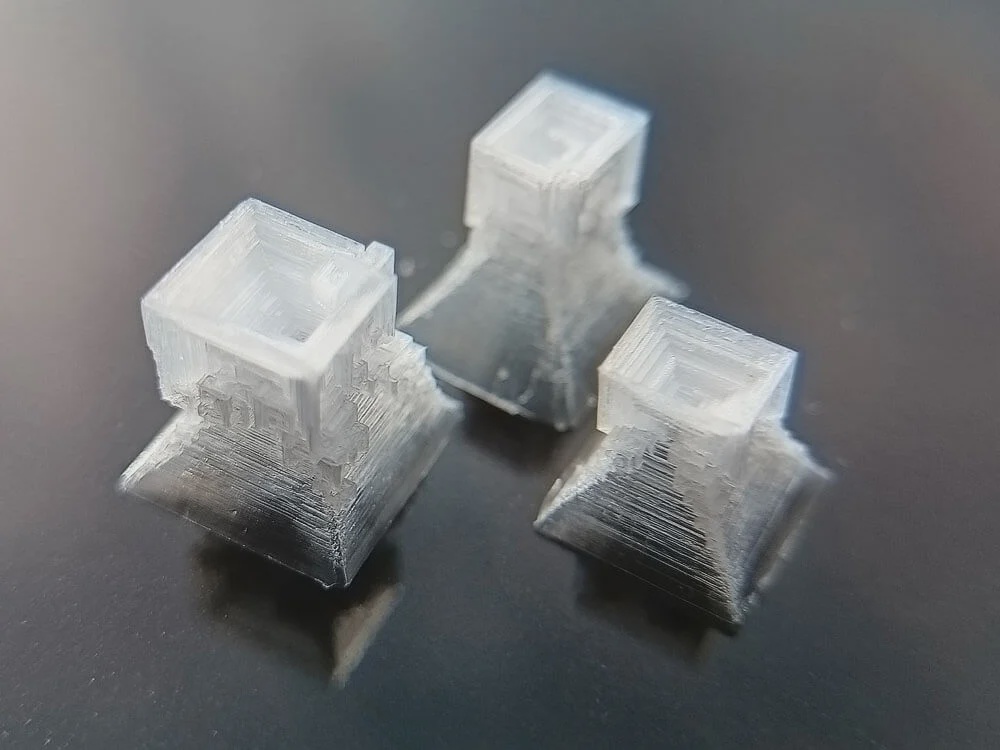
The so-called “head” is actually a large salt cube. When it starts forming, it looks like a tiny square on the surface of the solution.
所谓的“头”其实是一个大盐块。当它开始形成时,它看起来像溶液表面的一个小方块。
Then, as the crystal gets heavier, it sinks a little into the solution. As it sinks, layers of salt crystals grow on the face of the cube facing the sky, forming a pyramid. But the other sides of the crystal cube (that are underwater) also keep growing. Eventually, they form the “head” of the pyramid.
随着晶体变得越来越重,它会稍微沉入溶液中。当它沉下去时,盐晶体的层会在面向天空的立方体面上生长,形成一个金字塔。但是,晶体立方体的其他面(在水下的面)也会继续生长。最终,它们形成了金字塔的“顶部”。
Sometimes, the head is tiny. Sometimes the head is much larger, and you can see interesting patterns on the hopper crystal.
有时,晶体的顶部非常小。而有时,顶部会大很多,你可以看到跳跃晶体上的有趣图案。
If you place the pyramids upside down, they look remarkably like flowers. You might be able to serve some ketchup in them.
如果你把金字塔倒过来,它们看起来就像花一样。你甚至可以在其中倒入一些番茄酱。
Despite having spent an unhealthy amount of time on this project at home, I confess that there was one secret that escaped me: how to control the size of the heads.
尽管我在家中花费了大量的时间在这个项目上,我必须承认,有一个秘密我始终没能掌握:如何控制头部的大小。
At first, I thought it was due to different types of salt. So I tried comparing two types of salt – sea salt and rock salt. I found that the batch with sea salt gave big heads and rock salt gave small heads.
起初,我以为这是由于不同类型的盐造成的。于是,我尝试比较了两种盐——海盐和岩盐。我发现,使用海盐的那一批产生了大头,而使用岩盐的则产生了小头。
I thought I had my answer.
我以为我找到了答案。
After a few days, out of curiosity, I ran the two experiments again, side by side. This time, it was the opposite – sea salt gave small heads and rock salt gave big heads.
几天后,出于好奇,我再次同时进行了这两个实验。这次,结果却恰恰相反 - 海盐产生的是小颗粒,而岩盐产生的是大颗粒。
I was equal parts surprised and confused.
我感到既惊讶又困惑。
And we haven’t even gotten to the scary part yet.🔄 ❓
After 15 minutes, the heads on the sea salt pyramids started growing bigger, until they were just as big as the heads of the rock salt pyramids!🔄 ❓
Such was my hunt for the reason behind different head sizes. I tried changing the temperature and the type of container. I tried using deionized water. I even tried adding impurities such as vinegar and baking soda to the solution.
这就是我寻找头部大小差异原因的过程。我尝试改变温度和容器类型。我试过使用去离子水。我甚至尝试向溶液中添加杂质,如醋和小苏打。
But my efforts were mostly frustrating and fruitless. It was full of contradictions. I was as salty as the saturated salt solution and my mood as sour as the vinegar I added to it.
但我的努力大多是令人沮丧和无果的。这充满了矛盾。我就像饱和的盐溶液一样咸,我的心情就像我加入其中的醋一样酸。
My last hope was the effect of humidity. But I didn’t have a device to measure humidity. So I had to rely on a crude technique – obsessively checking the weather station reports. Based on the several experiments I did, there seemed to be some relationship:
我的最后一线希望寄托在湿度的影响上。但我并没有测量湿度的设备。所以我只能依赖一种粗糙的技术 - 过度地查看气象站的报告。根据我做的几次实验,似乎存在某种关系:
The lower the humidity, the smaller the pyramid head.
湿度越低,金字塔头部越小。
My tests were not conclusive, as occasionally large heads still formed on hot sunny days. But generally, drier days yielded smaller heads.
我的测试结果并非决定性的,因为在炎热的晴天,偶尔还是会形成大头。但通常来说,干燥的天气会产生较小的头部。
I’ll discuss this later. For now, let’s look at 3 other types of pyramids.
我稍后会讨论这个问题。现在,让我们看看另外三种类型的金字塔。
They were grown from the exact same salt solution – in which I had added a teaspoon of Epsom salt.
它们都是从我加了一茶匙硫酸镁的同样的盐溶液中生长出来的。
The first pyramid salt crystal that grew from this solution was an absolute beast. The humongous head was covered with all sorts of intricate formations that reminded me of bismuth crystals.
从这个溶液中生长出的第一个金字塔盐晶体简直是个庞然大物。巨大的头部覆盖着各种复杂的形状,让我想起了铋晶体。
After half an hour, I extracted this crystal with tweezers and dried it. Then, from the same solution, a different type of pyramid started forming:
半小时后,我用镊子取出这个晶体并将其晾干。然后,从同样的溶液中,开始形成了另一种类型的金字塔:
At first, it looked like a regular, small-headed pyramid. Then, it tilted over to one side and continued growing, until it looked like this:
起初,它看起来像一个普通的,头部较小的金字塔。然后,它向一侧倾斜并继续生长,直到它看起来像这样:
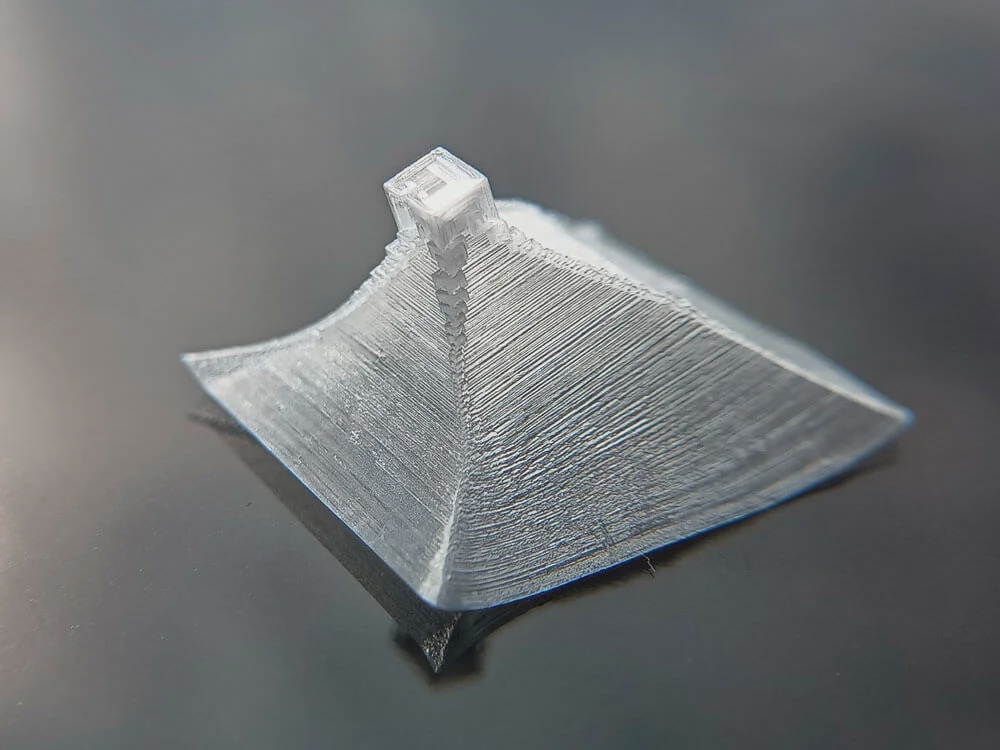
After removing the slanted crystal, more pyramids continued to form. These were regular symmetrical pyramids with small heads. But they were also very flat – the flattest I have ever seen:
在移除倾斜的水晶后,更多的金字塔继续形成。这些都是头部较小的规则对称金字塔。但它们也非常扁平 - 这是我见过的最扁平的:
3 different types of salt crystals forming from the same solution, barely an hour apart.
从同一溶液中形成的3种不同类型的盐晶体,仅相隔一个小时。
I was reminded once again that the art of crystal growing is both mysterious and wonderful.
我再次被提醒,水晶生长的艺术既神秘又奇妙。
Before writing this article, I have looked online for guides on how to grow pyramidal salt at home, and found nothing.
在撰写这篇文章之前,我在网上寻找了如何在家里培养金字塔形状的盐的指南,但是一无所获。
But I did find a study published in the World Salt Symposium where researchers successfully grew pyramid salt from waste salt water in large, steel crystallizers.
但我确实在世界盐研讨会上发表的一项研究中找到了一些信息,研究人员成功地在大型钢制结晶器中从废盐水中培养出了金字塔形状的盐。
They claim that calcium ions in seawater help pyramids form by allowing more salt to dissolve in water. I tried adding various amounts of calcium chloride to my solutions, and it had no noticeable effect.
他们声称海水中的钙离子通过让更多的盐溶解在水中,有助于金字塔的形成。我尝试向我的溶液中添加不同量的氯化钙,但并未产生明显的效果。
They also claim that a pH of 4, and a temperature of 55-65°C was good for pyramid growth. My experiments agree.
他们还声称,pH值为4,温度在55-65°C的环境有利于金字塔的生长。我的实验结果与此相符。
Since alum is mildly acidic, dissolving some alum in water would indeed yield a pH of around 4. But I have tried using other acids like vinegar and cream of tartar. Neither yielded pyramids. I suspect it has something to do with aluminum ions, because replacing potassium alum with aluminum sulfate worked.
铝石是轻微酸性的,所以将一些铝石溶解在水中确实会产生大约4的pH值。但我试过使用其他酸,如醋和塔塔酸。两者都没有产生金字塔。我怀疑这与铝离子有关,因为用硫酸铝替代钾铝石是有效的。
Finally, according to the authors, sulfate ions were bad for pyramid growth because they encouraged hopper cubes (we know them as “heads”) to form. After removing the sulfates, the researchers managed to grow nice regular pyramids.
最后,根据作者的说法,硫酸根离子对金字塔的生长不利,因为它们会促使跳跃立方体(我们称之为“头”)形成。在去除硫酸根后,研究人员成功地培养出了规则的金字塔。
I knew that sulfates were not the only factor that affects head size, because in my experiments, the same solution could form both big and small heads.
我知道硫酸盐并非影响头部大小的唯一因素,因为在我的实验中,同样的溶液可以形成大头和小头。
Nevertheless, I decided to try this hypothesis. I had no easy way to remove the sulfates, but I could add Epsom salt (magnesium sulfate) to my solutions.
尽管如此,我决定尝试这个假设。我没有简单的方法去除硫酸盐,但我可以在我的溶液中加入硫酸镁(即浴盐)。
You have seen the results in the previous section. The same solution formed monster pyramids, slanted pyramids and ultra wide pyramids, 1 hour apart. Maybe magnesium sulfate indeed makes the heads bigger, but then, it must be quickly used up, causing subsequent pyramids to have very small heads. But it’s hardly conclusive.
您已在前一部分看到了结果。同一种溶液在相隔1小时的时间里形成了巨大的金字塔、倾斜的金字塔和超宽的金字塔。也许硫酸镁确实会使金字塔的顶部变大,但随后,它必须被迅速消耗掉,导致后续的金字塔顶部非常小。但这个结论并不十分确定。
How do you control head size? Whether you’re a science loving kid or a research chemist, I leave it to you.
你是如何控制头部大小的?无论你是热爱科学的孩子还是研究化学家,我都交给你了。
That’s all for now. I have been trying to grow pyramid salt crystals for a very long time, and I’m glad to share what I’ve learnt with you. Hopefully you found the guide useful.
就到这里吧。我已经尝试了很长时间去培养金字塔形状的盐晶体,我很高兴能和你们分享我所学到的。希望你们觉得这个指南有用。
Here’s a super short summary of what we’ve covered.
以下是我们所讨论内容的超短小结。
***
Maybe you found a new hobby today. Maybe you’ll find a few hours of joy with your kids. Or maybe it simply put a small smile on your face.
也许你今天找到了新的爱好。也许你会和孩子们度过几个小时的快乐时光。或者,这只是让你脸上露出了微笑。
I grow crystals because it makes me happy, and I hope it made you happy too.
我种植水晶是因为这让我感到快乐,我也希望这能让你感到快乐。
If you want to start crystal growing, I also recommend making alum crystals. They are large, transparent and easy to grow.
如果你想开始培养水晶,我也推荐你制作明矾水晶。它们体积大,透明度高,且易于培养。
And if you enjoyed this guide, consider subscribing to my newsletter. Let’s keep in touch. I’ll share more crystal growing guides with you when they come out.
如果你喜欢这个指南,不妨考虑订阅我的新闻通讯。让我们保持联系。当有新的水晶培养指南出现时,我会与你分享。